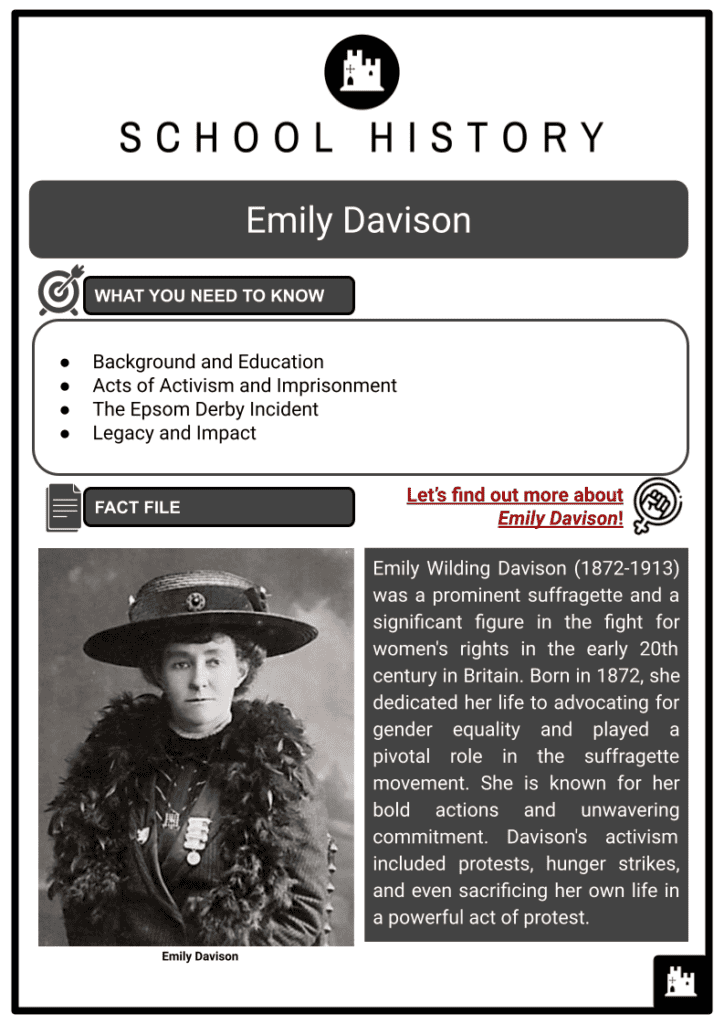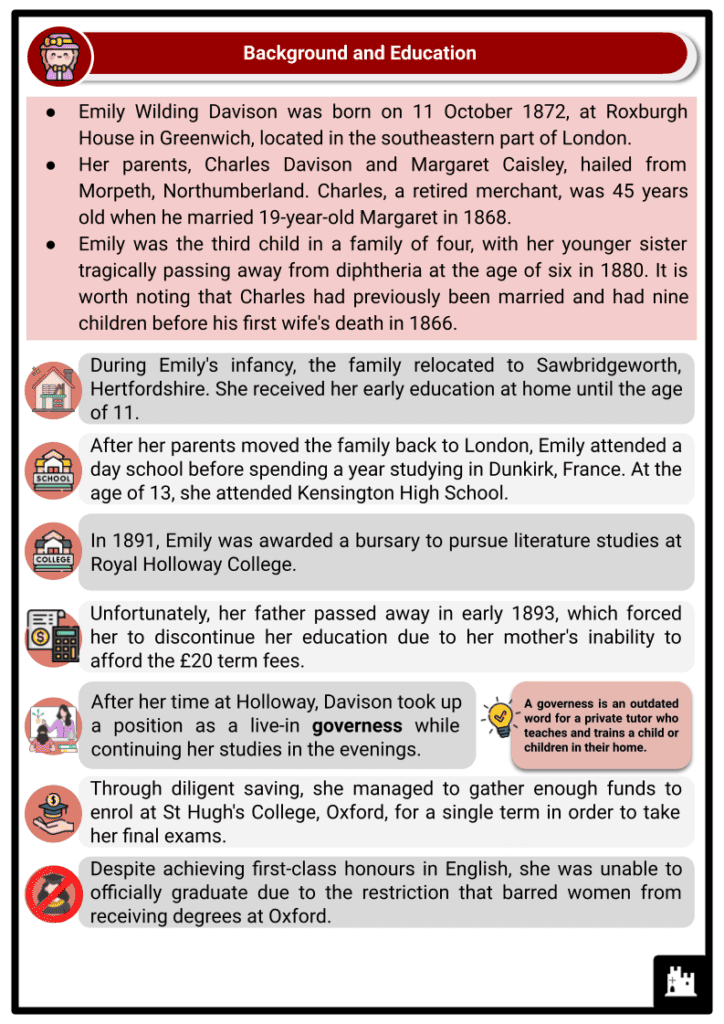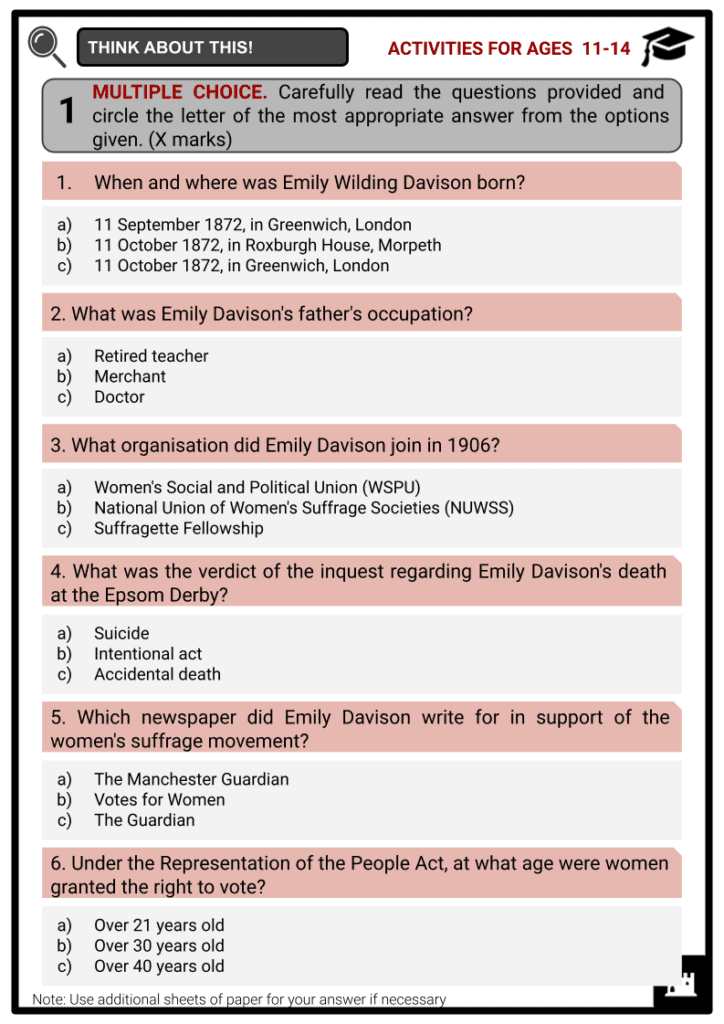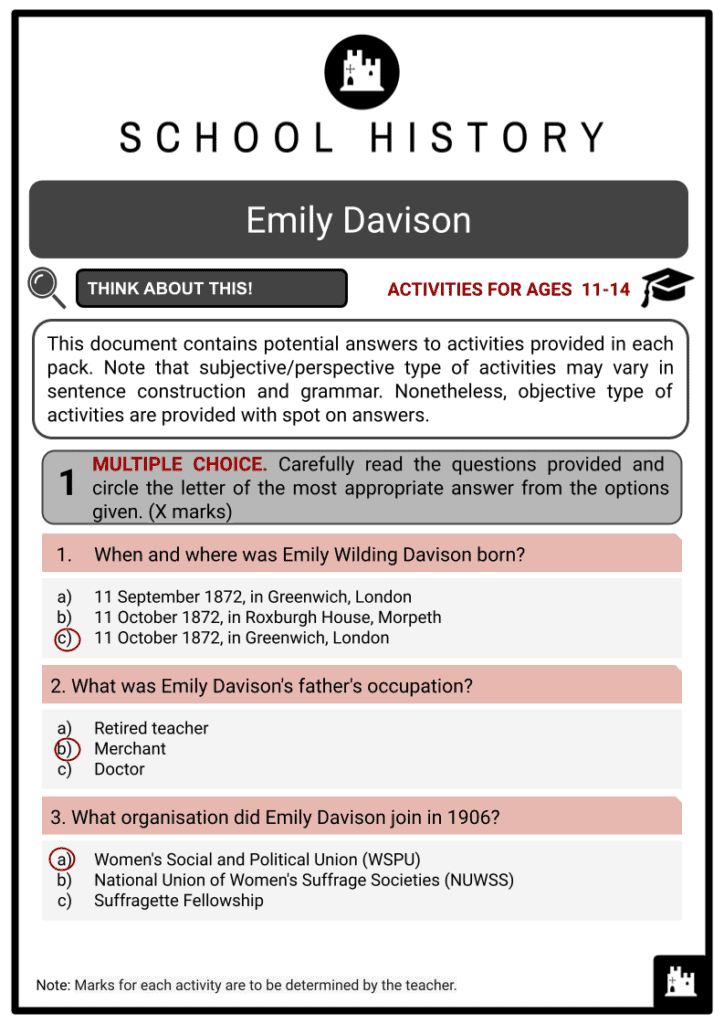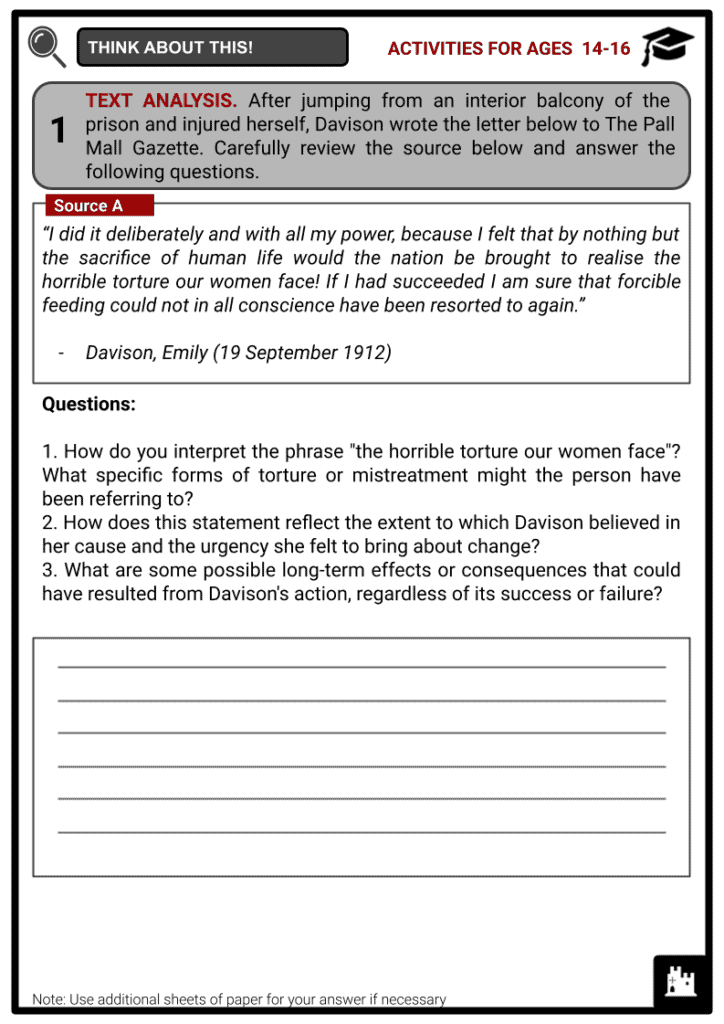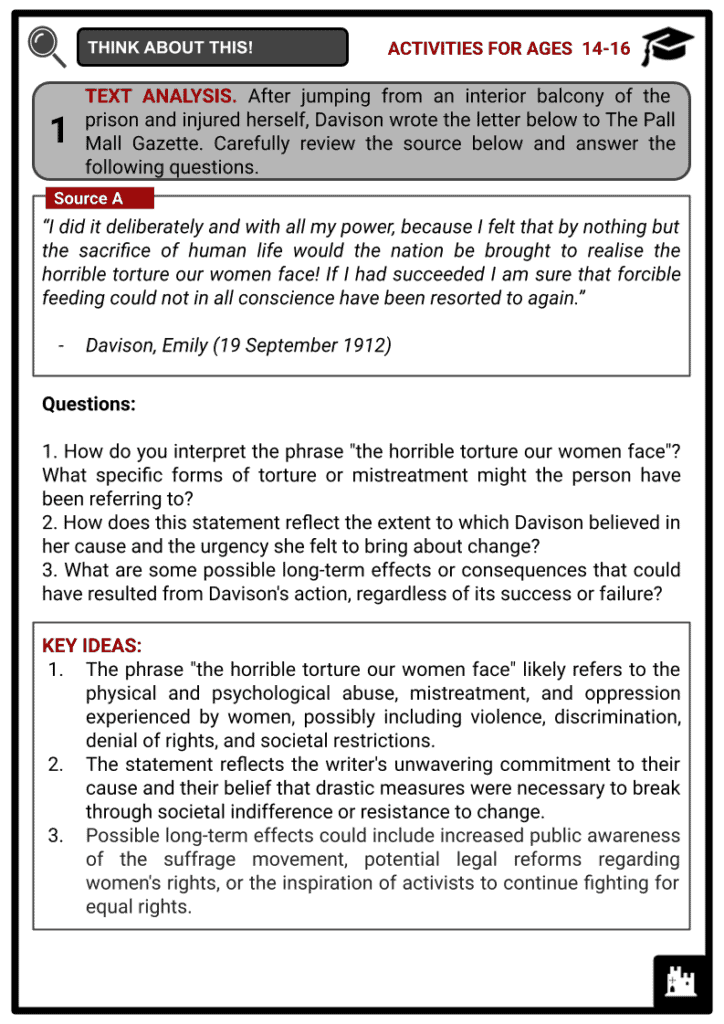Emily Davison Worksheets
Do you want to save dozens of hours in time? Get your evenings and weekends back? Be able to teach about Emily Davison to your students?
Our worksheet bundle includes a fact file and printable worksheets and student activities. Perfect for both the classroom and homeschooling!
Summary
- Background and Education
- Acts of Activism and Imprisonment
- The Epsom Derby Incident
- Legacy and Impact
Key Facts And Information
Let’s find out more about Emily Davison!
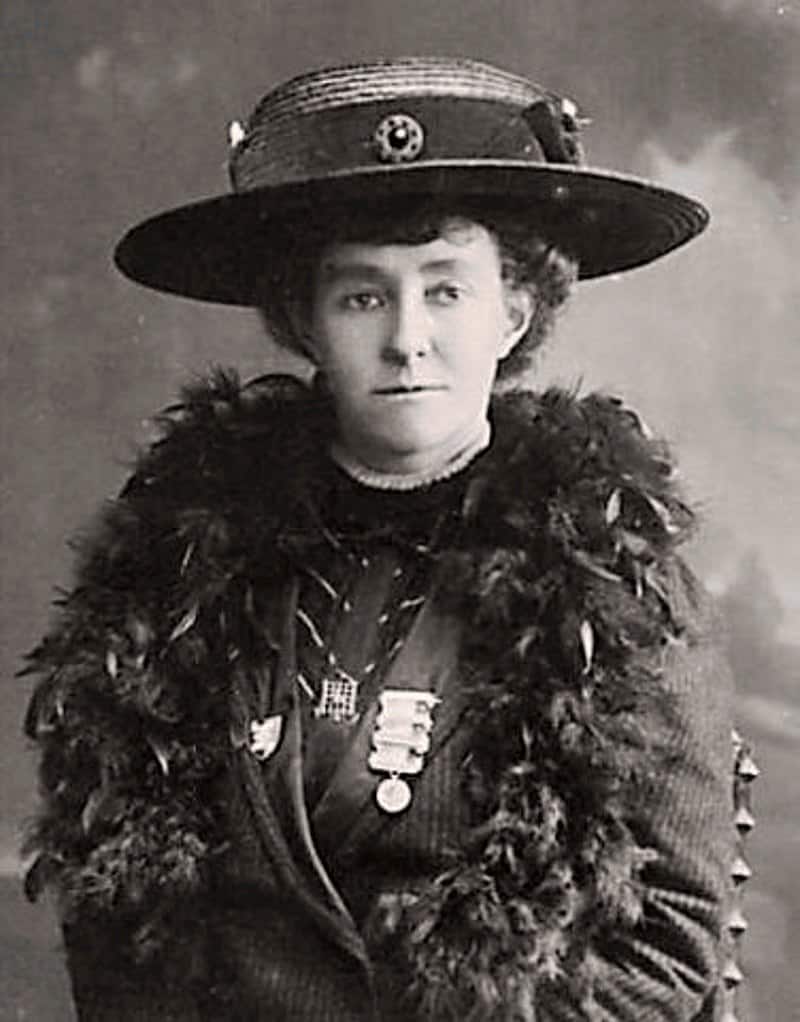
Emily Wilding Davison (1872-1913) was a prominent suffragette and a significant figure in the fight for women's rights in the early 20th century in Britain. Born in 1872, she dedicated her life to advocating for gender equality and played a pivotal role in the suffragette movement. She is known for her bold actions and unwavering commitment. Davison's activism included protests, hunger strikes, and even sacrificing her own life in a powerful act of protest.
Background and Education
- Emily Wilding Davison was born on 11 October 1872, at Roxburgh House in Greenwich, located in the southeastern part of London.
- Her parents, Charles Davison and Margaret Caisley, hailed from Morpeth, Northumberland. Charles, a retired merchant, was 45 years old when he married 19-year-old Margaret in 1868.
- Emily was the third child in a family of four, with her younger sister tragically passing away from diphtheria at the age of six in 1880. It is worth noting that Charles had previously been married and had nine children before his first wife's death in 1866.
- During Emily's infancy, the family relocated to Sawbridgeworth, Hertfordshire. She received her early education at home until the age of 11.
- After her parents moved the family back to London, Emily attended a day school before spending a year studying in Dunkirk, France. At the age of 13, she attended Kensington High School.
- In 1891, Emily was awarded a bursary to pursue literature studies at Royal Holloway College.
- Unfortunately, her father passed away in early 1893, which forced her to discontinue her education due to her mother's inability to afford the £20 term fees.
- After her time at Holloway, Davison took up a position as a live-in governess while continuing her studies in the evenings. A governess is an outdated word for a private tutor who teaches and trains a child or children in their home.
- Through diligent saving, she managed to gather enough funds to enrol at St Hugh's College, Oxford, for a single term in order to take her final exams.
- Despite achieving first-class honours in English, she was unable to officially graduate due to the restriction that barred women from receiving degrees at Oxford.
- Between 1895 and 1896, she worked for a short time at a church school in Edgbaston, but she struggled there and eventually transferred to Seabury, a private school in Worthing, where she felt more at home.
- In 1898, she left Worthing and took on the role of a private tutor and governess for a family in Northamptonshire.
- In 1902, she embarked on a degree programme at the University of London, ultimately completing her studies in 1908 and earning a third-class honours degree.
Acts of Activism and Imprisonment
- In November 1906, Davison became a member of the Women's Social and Political Union (WSPU).
- The WSPU, founded in 1903 by Emmeline Pankhurst, united individuals who believed that employing militant and confrontational tactics was necessary to achieve their ultimate objective of women's suffrage.
- Davison actively participated in the WSPU's campaigns and assumed roles as an officer of the organisation and a chief steward during marches.
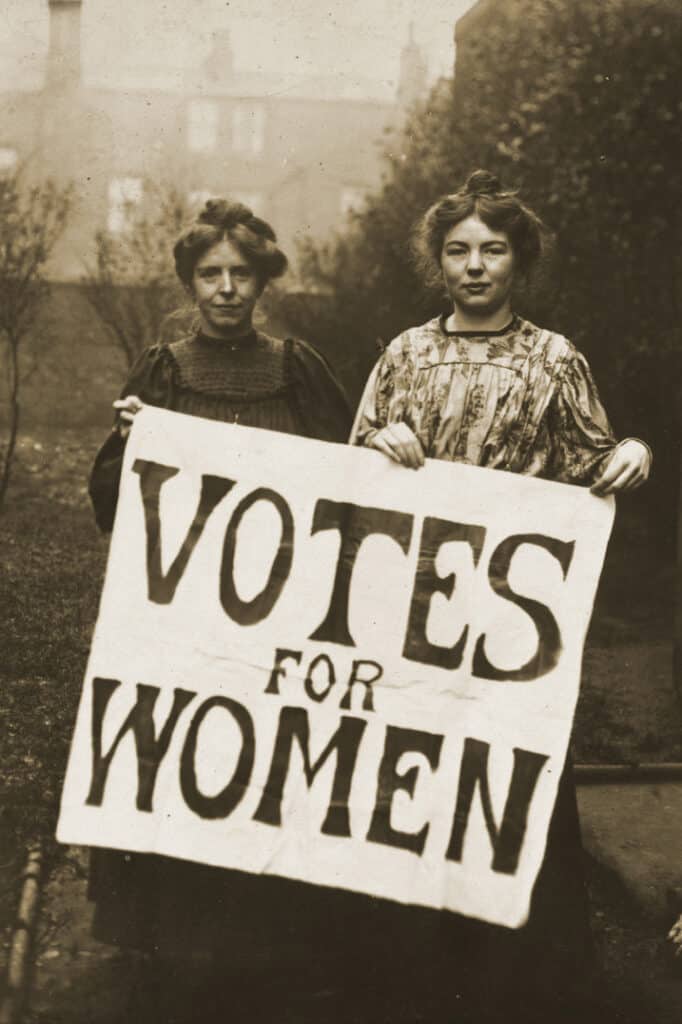
WSPU leaders Annie Kenney and Christabel Pankhurst - Around 1908 or 1909, she made the decision to leave her teaching job and devote herself full-time to the union.
- During this period, Davison progressively engaged in more confrontational actions, earning her the description from Sylvia Pankhurst, a dedicated WSPU member and Emmeline's daughter, as one of the most bold and courageous militants.
- In March 1909, Davison encountered her first arrest. She had been one of 21 women who marched from Caxton Hall to see Prime Minister H. H. Asquith.
- Unfortunately, the march turned chaotic as clashes erupted between the women and the police.
- Davison was subsequently arrested on charges of attacking the police officers while performing their duties.
- She received a one-month prison sentence for her actions.
- Upon her release, she penned a letter to Votes for Women, the newspaper of the WSPU, expressing, "Through my humble work in this noblest of all causes, I have discovered a sense of fulfilment and a level of interest in life that I had never experienced before."
- In July 1909, alongside fellow suffragettes Mary Leigh and Alice Paul, Davison was apprehended for disrupting a public meeting that excluded women.
- The meeting was conducted by David Lloyd George, the Chancellor of the Exchequer. Davison received a two-month sentence for obstruction.
- During her time in custody, she embarked on a hunger strike and was eventually released after five and a half days.
- Throughout this period, she endured a weight loss of 21 pounds (9.5 kgs) and expressed feeling significantly weakened as a consequence.
- In September of the same year, she faced another arrest for her involvement in throwing stones to shatter windows at a political gathering.
- This assembly, aimed at protesting the 1909 budget, was strictly limited to male attendees. Davison was subsequently sent to Strangeways Prison for a period of two months.
- She went on another hunger strike and was eventually released after two and a half days.
- She later penned a letter to The Manchester Guardian in order to defend her act of hurling stones, stating that it was intended as a cautionary gesture to the general public about the potential personal risks they may face in the future if they attend Cabinet Ministers' gatherings anywhere. The Manchester Guardian is a daily newspaper in Britain that was founded in 1821. It changed its name to The Guardian in 1959.
- Furthermore, she expressed that this action was warranted due to the "unconstitutional behaviour of Cabinet Ministers" who addressed "public meetings" from which a significant portion of the public was excluded.
- In early October 1909, Davison was arrested once more when she was caught getting ready to throw a stone at Sir Walter Runciman, a cabinet minister.
- She mistakenly believed that the car he was in contained Lloyd George (Chancellor of the Exchequer). Before the police could intervene, one of Davison's suffragette colleagues, Constance Lytton, threw her stone first.
- Davison was charged with attempted assault but later released, while Lytton was sentenced to a month in prison. During her court appearances, Davison took the opportunity to deliver speeches, and snippets and quotes from these speeches were published in the newspapers.
- She threw stones at Runciman during a political gathering in Radcliffe, Greater Manchester, two weeks later. As a consequence, she was apprehended and handed a one-week sentence of hard labour. Once again, she resorted to a hunger strike, but the government had authorised the practise of force-feeding prisoners. Davison expressed that the experience would forever be etched in her memory with its horrifying nature and was nearly impossible to describe. She referred to the ordeal as barbaric torture.
- In April 1910, Davison tried to get into the House of Commons so she could talk to Prime Minister Asquith about giving women the right to vote.
- She went into the Palace of Westminster with other people and got into the heating system, where she stayed hidden for the night.
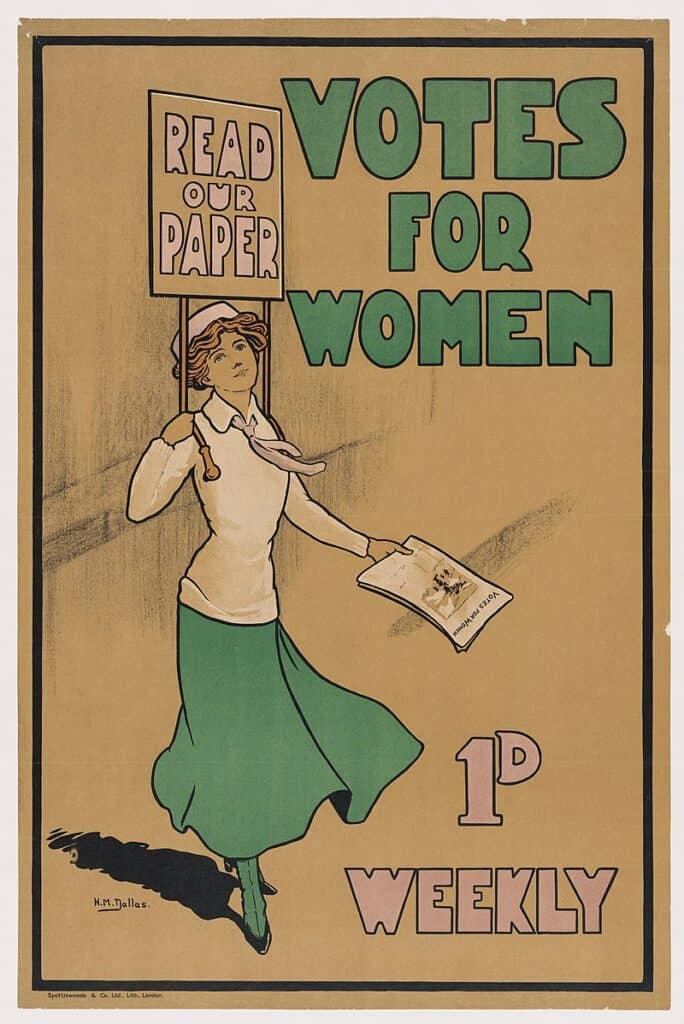
Hilda Dallas's Votes for Women poster (1903 onwards) - She was caught by a police officer when she left her hiding place to get water.
- However, she was not charged. She started working for the WSPU and writing for Votes for Women in the same month.
- Votes for Women was a newspaper that supported the women's suffrage movement in the UK. It was the official publication of the Women's Social and Political Union, the leading suffragette organisation, until 1912.
- Davison demonstrated her unwavering commitment to the cause she devoted her life to, even showing readiness to sacrifice her life.
- In 1912, she was imprisoned once more, this time for a duration of 10 months, for setting fire to London post boxes.
- During her incarceration, she resumed her hunger strike, leading the prison authorities to resort to force-feeding. In protest against this treatment, Emily threw herself from a balcony.
- Due to her actions, she suffered significant injuries, including two fractured vertebrae and a severe head injury.
- As a consequence, Davison experienced ongoing discomfort for the remainder of her life. Her unauthorised arson of postboxes, along with her other independent actions, caused her to lose favour with the leadership of the WSPU.
- Sylvia Pankhurst later mentioned that the WSPU leadership aimed to discourage Davison from pursuing such tendencies and viewed her as a self-willed individual who acted without waiting for official instructions, leading to her condemnation and ostracisation within the organisation.
The Epsom Derby Incident
- On 4 June 1913, Davison attended the renowned Epsom Derby, the most famous horse race in Britain.
- During the race, with the King's horse, Anmer, participating and a large crowd watching, Davison positioned herself at the final bend known as Tattenham Corner.
- As Anmer approached the curve, Davison emerged from behind the safety barricade separating the track from the spectators and was struck by the racehorse.
- The collision rendered her unconscious and threw off the jockey, and the horse continued on to finish the race. Unfortunately, Davison did not regain consciousness and passed away on 8 June 1913 at the age of 40.
- Her funeral showcased the unity of the suffrage movement, with newspaper reports noting that over five thousand women participated in the procession through London.
- The inquest regarding Davison's death occurred in Epsom on 10 June. Captain Henry Davison, Emily's half-brother, provided testimony, describing her as a woman with strong reasoning abilities and a passionate dedication to the women's movement.
- The coroner concluded that, in the absence of evidence suggesting otherwise, Davison's death was not a result of suicide.
- Furthermore, the coroner determined that although she had waited until she could see the horses, it was evident from the evidence that she did not specifically target His Majesty's horse.
- The court's verdict stated that Davison's demise was caused by a skull base fracture resulting from accidentally being struck by a horse while intentionally rushing onto the racecourse at Epsom Downs during the Derby race. The cause of death was ruled as misadventure.
Legacy and Impact
- Davison's death marked a significant milestone and a turning point in the militant suffragette campaign. The following year, the outbreak of the First World War led to a shift in the government's approach.
- On 10 August 1914, all women hunger strikers were released, and an amnesty was declared. In response, Emmeline Pankhurst suspended operations of the WSPU on 13 August. Subsequently, Pankhurst collaborated with the government in recruiting women for war-related work.
- The Fourth Reform Act (also known as Representation of the People Act 1918) was enacted by Parliament. Women over 30 years old who met property requirements were granted the right to vote as part of the reforms.
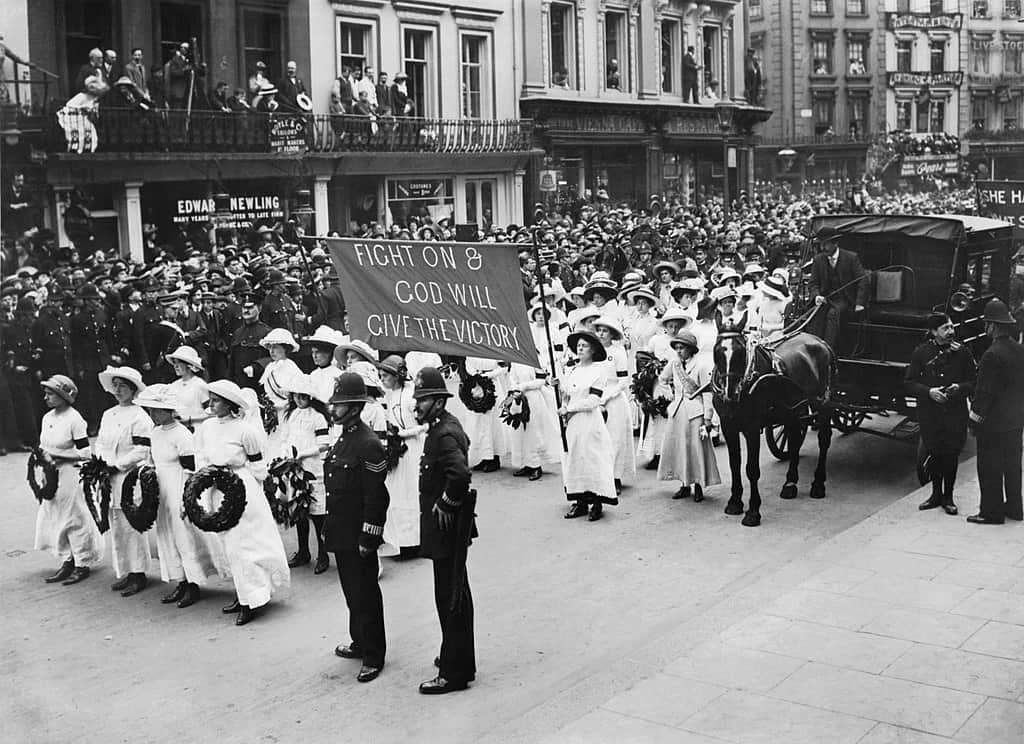
Davison's funeral procession - As a result, 8.5 million women were added to the electoral roll, constituting 43% of the electorate. It wasn't until 1928 that the Representation of the People (Equal Franchise) Act lowered the voting age for women to 21, placing them on equal footing with male voters.
- Davison's commitment to the cause of women's suffrage made her a symbol of courage and determination. Her unwavering dedication continues to inspire activists and feminists worldwide, serving as a reminder of the ongoing struggle for equality.
- By engaging in acts of civil disobedience and direct action, such as protests, hunger strikes, and disrupting public events, Davison challenged societal norms and drew attention to the suffragette movement.
- The dramatic and tragic events of Davison's life, including her imprisonment, hunger strikes, and ultimately her death, brought international attention to the suffragettes' cause. Her sacrifice captured public sentiment and helped galvanise support for women's suffrage, ultimately leading to the extension of voting rights to women.
Image Sources
- https://en.wikipedia.org/wiki/Emily_Davison#/media/File:Emily_Wilding_Davison.jpg
- https://en.wikipedia.org/wiki/Women%27s_Social_and_Political_Union#/media/File:Annie_Kenney_and_Christabel_Pankhurst.jpg
- https://en.wikipedia.org/wiki/Votes_for_Women_(newspaper)#/media/File:Votes_for_Women_poster,_ca._1903-1926._(17311553535).jpg
- https://en.wikipedia.org/wiki/Emily_Davison#/media/File:Britain_Before_the_First_World_War_Q81834.jpg

